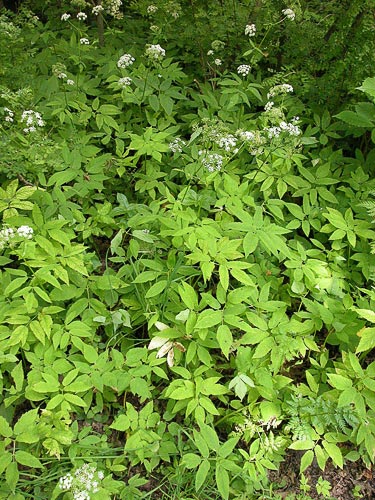Weeds
Aegopodium podagraria L. - Ground-elder.
Systematic position.
Family Apiaceae Lindl. (Umbelliferae Juss.), genus Aegopodium L.Biological group.
Long-rhizome perennial weed.Morphology and biology.
Stem 50-100 cm in height, fistular, glabrous or covered with short-branched hairs, somewhat branchy at top. Lower leaves long-petiolate, broad-triangular, densely and shortly pubescent from below and along ribs, glabrous from above, sometimes rough along ribs. Leaves twice tripartite; leaflets elongate-ovate, irregularly acute-serrate, pointed, on short petioles; lateral leaflet unequal-sided. Upper leaves smaller, with short petioles expanding at sheath. Apical umbel to 9 cm in diameter; 12-20 or more umbel rays are shortly and rigidly pubescent. Lateral umbels smaller and usually fruitless. Involucre and involucel are absent; umbellules 10-15 mm in diameter; petals white, 1.5 mm in length. Fruits are oblong, slightly compressed laterally, 3-4 mm in length. Blossoms from the beginning of June to middle of September. Maturing of fruits in the beginning of August. The species easily and quickly propagates due to formation of underground offshoots, being difficult to eradicate.Distribution.
Middle and Atlantic Europe, adventive in North America. Inhabits the European part of the former USSR except for the Far North; the Caucasus, Western and Eastern Siberia (to Yenisei river), mountains of Central Asia (Saur, Tarbagatai, Dzungarian Alatau, Tien-Shan).Ecology.
Plants grow in forests and bushes, in weedy places, clearings, gardens, and parks. They prefer nitrogen-rich, mainly carbonate, loamy and clay soils.Economic significance.
The species grows in ruderal habitats and also in gardens, kitchen gardens, among fruit bushes. Control measures are cleaning of sowing material or ground to escape contamination by seeds of the weed; regular destruction of rhizomes with the help of the appropriate types of soil treatment and by use of herbicides.Reference citations:
Maevskii P.F. 1954. Flora of middle belt of the European part of the USSR. Moscow, Leningrad: Gosudarstvennoe Izdatel.stvo Sel.skokhozyaistvennoi Literatury, 912 p. (in Russian).Shishkin B.K., ed. 1957. Flora of the Leningrad Region. V. 3. Leningrad: Leningrad University, 268 p. (in Russian).
Ulyanova T.N. 1998. Weed plants in the flora of Russia and other CIS states. St.Petersburg: VIR, 344 p. (in Russian).


